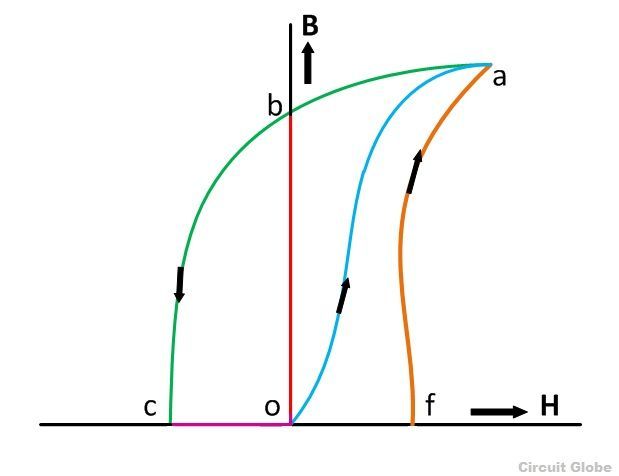Residual magnetism is defined as the amount of magnetization left behind after removing the external magnetic field from the circuit.
In other words, the value of the flux density (ob as shown in the figure with the red colour line) retained by the magnetic material is called Residual Magnetism and the power of retaining this magnetism is called Retentivity of the material.
Magnetization occurs by applying the current in one direction, and the flux density is increased until the saturation point (a) is reached. Now to demagnetize the magnetic ring the magnetizing force H is reversed by reversing the direction of flow of the current, as discussed in the article ‘Magnetic hysteresis‘.
When H is increased in the reverse direction, the flux density starts decreasing and become zero and the curve follows the path (bc) as shown in the figure below. This residual magnetism of the magnetic material is removed by applying magnetizing force (oc) called the coercive force in the opposite direction.
 This phenomenon of the residual magnetism is widely seen in the transformers, generators, and motors. It is also called as Remanence.
This phenomenon of the residual magnetism is widely seen in the transformers, generators, and motors. It is also called as Remanence.
Types of Remanence
Contents:
- Saturation Remanence
- Isothermal Remanence
- Anhysteretic Residual Magnetism
- Reduction of Residual Magnetism
The various types of Remanence are as follows
- Saturation Remanence
- Isothermal Remanence
- DC demagnetization residual magnetism
- AC demagnetization residual magnetism
- Anhysteretic Remanence
 Detailed explanation of the various types of remanence is given below:
Detailed explanation of the various types of remanence is given below:
Saturation Remanence (SIRM)
Saturation Remanence is the total magnetic moment per volume of the sample. It is denoted by Mr, and it is sometimes also called as saturation Isothermal Remanence, denoted by Mrs.
Isothermal Residual Magnetism (IRM)
Generally, by one method of remanence, you cannot identify the residual magnetism of all the magnetic materials as they are different in dimensions, shapes, and properties, thus to measure the residual magnetism of small magnetic particles isothermal Remanence is used. It is denoted by Mr(H).
This method mainly depends on the magnetic field of the material. In this method first the magnetic material is magnetized in an alternating field and after that magnetizing field, H is applied and then removed. It is also called as Initial Remanence.
The Isothermal Remanence is further categorized into two methods
- DC Demagnetization Remanence
This method is also called as DC Demagnetization residual magnetism. It is denoted by Md(H). In this process, the magnet is magnetized in one direction by applying the electric current until it reaches the saturation point, and then applying the current in the opposite direction and removing the magnetic field.
- AC Demagnetization Remanence
As the name itself suggests that AC means the magnet or the magnetic material is magnetized in an (AC) alternating current field and the saturation point is obtained. It is denoted by Ma(H).
. Anhysteretic Residual Magnetism (ARM)
Anhysteretic Remanence is a method in which the magnetic material is placed in a large alternating magnetic field with a small amount of DC bias field. To get remanence, the amplitude of the alternating field is reduced to zero gradually and then the bias DC field is removed from the circuit.
Reduction of Residual Magnetism
Residual Magnetism can be reduced by the following methods
- It can be reduced by 45-50 % by the use of hot-rolled steel material.
- The saturation level of the magnetic material can be decreased by providing higher exciting current.
- The magnetization process should be started with constant force and gradually increasing until the saturation is achieved and then reducing it slowly to demagnetize it further.
- In the process of magnetization and demagnetization of magnetic material the electric force, or the applied current should almost be similar.
